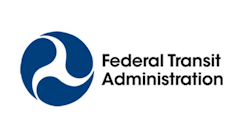The Federal Transit Administration is celebrating its 60th anniversary. On July 9, 1964, President Lyndon Johnson signed into law the Urban Mass Transportation Act of 1964, creating the federal transit program, which allowed the federal government to take on a major role in supporting transit bus and rail systems across the U.S. The law was signed shortly after another landmark piece of legislation, the Civil Rights Act of 1964.
During the past 60 years, FTA says the federal transit program has reshaped transit in America, helping it evolve from scattered, poorly funded bus systems and a few big-city subways to light rail, commuter rail, bus and bus rapid transit, ferry systems, rural transit and services for seniors and people with disabilities in thousands of communities. Today, FTA supports more than 3,500 transit agencies nationwide to ensure everyone can fully participate in their community, riding to work, school, healthcare appointments and to see family and friends. The agency’s programs are helping modernize transit, alleviate the climate crisis, improve access, advance research and innovation, promote civil rights, provide safety oversight and create jobs.
The 1964 legislation allocated $375 million to support expansion projects for bus, rail and streetcar systems. The first grants included:
- $6 million to the Massachusetts Bay Transportation Authority in Boston, Mass., to modernize rapid transit stations.
- $565,740 to the city of Minneapolis, Minn., to build Nicollet Avenue Transit Mall, an eight-block downtown bus-only area.
- $77,000 to the city of Vallejo, Calif., to purchase new buses.
Four years later, the federal transit program moved from its original home at the U.S. Department of Housing and Urban Development to the newly created U.S. Department of Transportation and was then administered by a new agency, the Urban Mass Transportation Administration (UMTA). One of UMTA's first major projects was an $18 million grant to the city of Pittsburgh, Pa., to develop the U.S.’s first federally supported rapid bus line. Pittsburgh’s innovative new system ran in a bus-only lane and connected riders with frequent service between downtown and the airport.
FTA notes that bus rapid transit is currently the U.S.’s fastest-growing transit type. Since 2016, 317 miles of FTA-funded rapid transit lines have been put into service in the U.S.
In 1971, UMTA awarded the first federal grant to support transit on an American Indian reservation. The $120,000 grant to the Mandan, Hidatsa and Arikara Nation (the Three Affiliated Tribes) of the Fort Berthold Indian Reservation in North Dakota helped create a 650-square-mile transit network. The four routes connected tribal residents with jobs, schools, healthcare and essential services. Today, FTA's Tribal Transit Program awards millions of dollars a year to provide critical transportation services for American Indian and Alaska Native communities.
The Americans with Disabilities Act (ADA) of 1990 created new requirements for transit to be accessible to people with disabilities. FTA notes it took a lead role supporting U.S. transit systems fulfilling the ADA. Today, every fixed-route bus fleet is accessible to all. To help make all rail stations accessible, including those from the pre-ADA era, the Infrastructure Investment and Jobs Act (IIJA) signed by President Joe Biden in November 2021 provides $1.75 billion through 2026 for the All Stations Accessibility Program. By improving pre-ADA stations to ensure people with disabilities can get on board with the same ease as anyone else, the program advances equity in transit.
Following the Sept. 11, 2001, terrorist attacks in the U.S., FTA established the Lower Manhattan Recovery Office to coordinate transit recovery, including damage to the New York Metropolitan Transportation Authority’s subway system. FTA’s team administered $4.5 billion in projects to recover and revitalize Lower Manhattan, N.Y.
As part of an interest in making the safest mode of surface transportation even safer, the Moving Ahead for Progress in the 21st Century Act of 2012 made major changes to the rail transit state safety oversight program and provided FTA with expanded authority to ensure the safety of public transportation. Following a IIJA requirement, FTA recently updated the Public Transportation Agency Safety Plans regulation to lessen risk and promote systems-based approaches to protect transit riders and workers.
In recent years, FTA supported public transit agencies with $69.5 billion to cover capital, operating and other expenses to mitigate the effects of the COVID-19 pandemic. Most recently, since the IIJA was signed, FTA has awarded $68.3 billion to more than 9,400 transit projects using combined funding from the IIJA, prior authorizations and annual appropriations.
"Since our founding as the Urban Mass Transit Administration, we have been passionately committed to improving America's communities through public transportation," said FTA Acting Administrator Veronica Vanterpool. "We support more than 3,500 transit agencies and state Departments of Transportation to ensure all Americans can fully participate in public life, riding to work, to the doctor, to shop and to see family and friends. Thanks to President Biden’s Bipartisan Infrastructure Law, we have an even bigger impact, helping transit agencies modernize and expand their systems."
Building on the foundation of the 1964 law, the federal transit program today is looking toward the future, with FTA continuing to administer the record funding under the IIJA to better support transit providers and improve public transportation for people across America.





